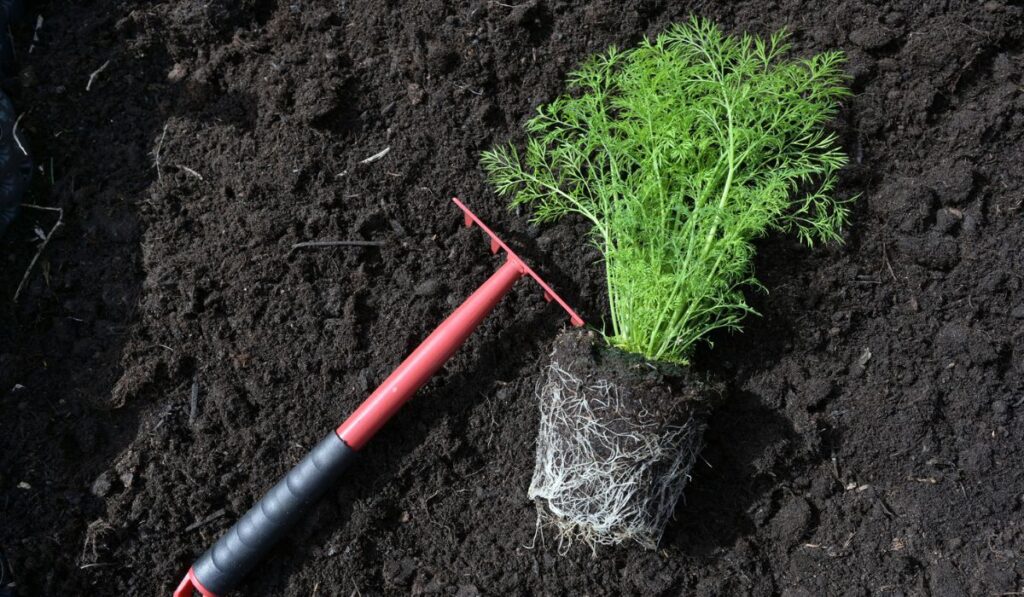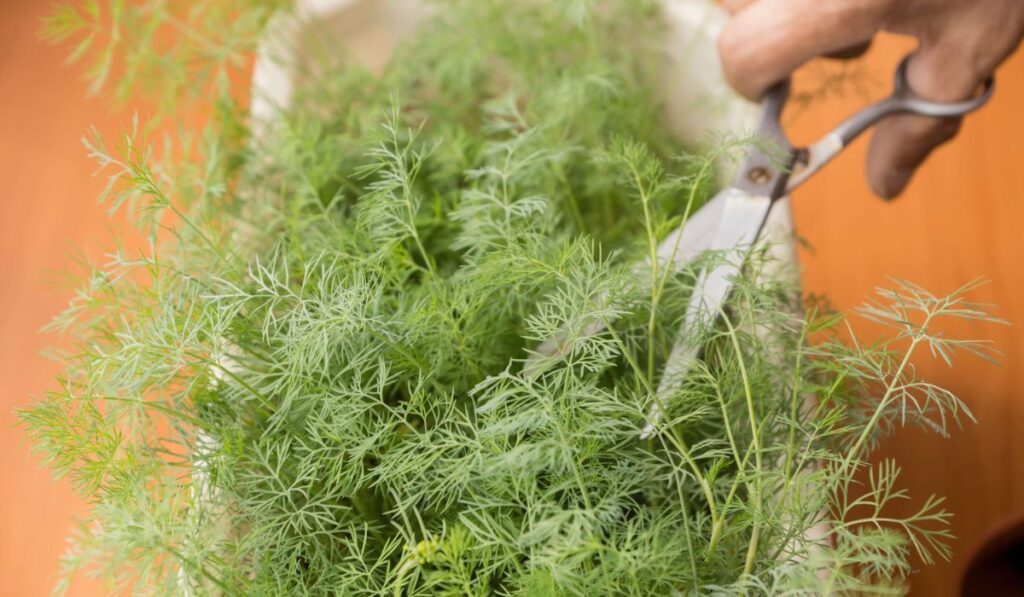If you are a fan of dill plants, then you must want to see them flourishing in your garden. If yes, this is the right guide for you. It explains everything you need to know about when to plant dill and how to maintain them.
Dill can be planted safely after two weeks have passed without a frost. The optimal soil temperature for planting is between 65 and 75 degrees Fahrenheit. The right time to sow dill herb seeds is in the spring.
Mostly dill seeds are planted between mid-April and the end of May to guarantee that plants have sufficient heat to continue developing healthily. However, there are different tips and tricks for maintaining dill. Let’s find out about them all!
When to Plant Dill?

Four to six weeks before planting in the garden, dill seed (on Amazon) can be started indoors. Because seedlings develop taproots challenging to transfer, dill is most simply started and grown in place. Plant seedlings in the spring after the last frost has passed.
Dill has a taproot and is difficult to transplant. Plant dill in the garden once the frost threat has passed. Plant seeds in 5-inch rows or bands. Dill quickly self-seeds, so plant it in a spot where it can flourish for several years. Sow consecutive dill crops every three to four weeks for a continual harvest.
Before planting this herb in your garden, you should also be aware that, although annual, it tends to self-sow. Therefore, seeds from grown plants land in your garden soil will grow into full-grown plants without your assistance next year.
Dill Varieties
Do you know that there are many different kinds of dill from which you can make your selection? Each type has a unique taste, cultivation method, and even physical traits and appearances.
Here are some varieties of dill from which to choose.
Bouquet
This cultivar gets its name because its tall branches and large, beautiful umbels of bright yellow blooms are frequently used in cut flower bouquets.
It has attractive dark-green foliage, making it an excellent edible ornamental plant for the garden. In other words, this dill is multipurpose. Perhaps this is why it is one of the most extensively cultivated varieties.
Due to its great seeds, this is a fantastic alternative for making pickles. Additionally, it is frequently used to make a calming tea.
Fernleaf
1992 winner of the All-America Selections award, ‘Fernleaf’ reaches a mature height of 18 inches and has a compact growth habit. It is perfect for container gardening and small herb gardens.
As you may have imagined, the leaves are fern-like in appearance. You can enjoy using them as filler in floral arrangements because they are beautiful and have a wonderful dill aroma.
The leaves keep their flavor after harvesting longer than other types. For example, the leaves of ‘Fernleaf’ are available for harvest after 40 to 60 days, and the seeds after 90 to 100 days.
Long Island Mammoth
This variety of dill, which may reach a height of 30 inches, is brilliant, aromatic, and simple to cultivate. This dill should be planted towards the sun, where it receives full and direct sunshine and in loose, easily-drained soil.
Long Island Mammoth thrives both indoors and outdoors, providing it receives sufficient sunlight. If you prefer to plant it inside, ensure that the pot is at least 12 inches deep, as dill has long taproots comparable to carrots.
Its leaves are green and have a robust flavor, making it an excellent ingredient for chefs.
Compatto
Compattos, like Bouquet, are well-known for their gorgeous foliage. This variety of dill is quite sturdy and can withstand some neglect in terms of watering. Additionally, it thrives in hot weather circumstances.
Compatto requires sun and well-drained, fertile soil; therefore, it is best cultivated outside. You can still grow plants indoors, but you must ensure that they receive sufficient sunlight and are kept warm.
Compatto’s dried seeds are frequently used for pickling, while the plant’s blossoms make an excellent complement to a floral arrangement.
How to Plant Dill?
You won’t have to stress too much about which soil to use while planting dill. A regular potting mix should be enough, but you can improve water retention by combining it with coco coir or a seed-starter blend.
You can buy potting mix such as Miracle-Gro Indoor Potting Mix (on Amazon) to mix with soil to make it better for dill.
You can easily sow little, flat dill seeds in your soil. However, Dill seeds need some sunshine to germinate. Plant seeds no deeper than 5mm (14″) in rows 45cm (18′′) apart. Space the plants at least 15 cm (6 in) apart. Dill prefers suitably moist soil, so never allow it to become very dry.
Like herbs, it does not require much fertilizer; however, a single application of a 5-10-5 fertilizer in the spring may promote its growth.
Consider the following guidelines when planting dill.
- Plant dill in an area that receives between six and eight hours of daily direct sunlight.
- Dill is difficult to transplant. Carefully sow seeds into the soil where the plants will grow.
- Growing dill indoors is doable if sufficient light is provided.
- Sow dill seeds around 1/8 inch deep.
- After ten to fourteen days, seedlings should emerge.
If the plants are not already well-spaced, wait for another 10 to 14 days and then thin them to about 10 to 12 inches apart.
Maintaining Dill Plants
Light
You should choose where you will plant your dill in your garden so that it will be exposed to direct sunshine for at least six to eight hours per day. A bit of afternoon shade is acceptable and desired during the summer if you live in a particularly hot environment.
Soil
Gardeners who want to grow dill will need rich, loose, and well-draining soil. Dill is indifferent to soil pH, although it grows best in slightly acidic soil. Also, remember that dill plants have a taproot (a central main root from which lesser roots sprout). Thus compacted soil could be a problem.
Sunlight
This plant thrives in a place that receives six to eight hours of direct sunlight daily. You can still plant dill in partial shade, but you may need to stake it because its stems will not be as firm. If your region is prone to strong winds, staking might also be advantageous.
Fertilizing
To fertilize a seedling, it can be broadcast (spread out over the ground) or applied as a side dressing (applied to the soil on or around the sides of the plant). It should not be used directly on the seed.
Generally, a formulation such as 20-20-20 should be applied once in late spring at a rate of 0.70 pounds per 100 square feet. Gardeners frequently use “Triple 20” fertilizer since it is widely available at garden centers.
Harvesting And Storing Dill

While dill leaves can be harvested year-round, the optimal time to harvest dill weed is right before the plants begin to blossom. It is when the oil in the leaves is at its most strong and flavorful.
To maximize the harvest of your growing dill weed, prevent the plants from flowering and producing seeds. Typically, harvesting herbs, including dill, is advised on a dry day.
Start early and harvest dill weed in the early morning, just as the dew from the previous night evaporates from the plant, but before the temperature rises.
The freshest dill leaves offer the finest flavor. However, they can be stored for many days in the refrigerator with their stems in a jar of water and a plastic bag covering them.
They can be stored in the refrigerator for several months if they are layered with pickling salt in a covered container. When you’re ready to utilize the leaves, wash them and use them as you would fresh leaves. You can also preserve fresh dill by freezing it.
